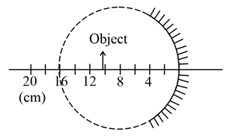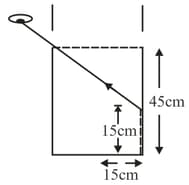A spherical mirror is obtained as shown in the figure from a hollow glass sphere, if an object is positioned in front of the mirror, what will be the nature and magnification of the image of the object? (Figure down as schematic and not to scale)



Important Questions on Ray Optics
A light ray enters a solid glass sphere of refractive index at an angle of incidence . The ray is both reflected and refracted at the farther surface of the sphere. The angle (in degrees) between the reflected and refracted rays at this surface is:
An observer can see through a small hole on the side of a jar (radius ) at a point at height of from the bottom. The hole is at a height of . When the jar is filled with a liquid up to a height of the same observer can see the edge at the bottom of the jar. If the refractive index of the liquid is , the value of is:

